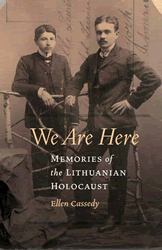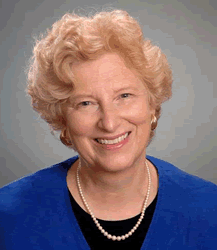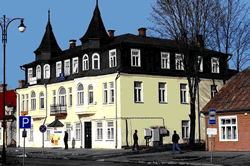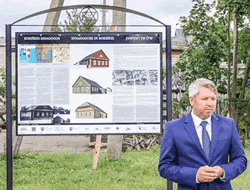|
In researching the Ancestry.com passport records, I found the following quite interesting one for a Rokishoker as follows:
Abel ADELSOHN, born September 1, 1842. Left Hamburg on the Germania on May 1 1886. He lived in Garden City, Kansas. He was naturalized before the District Court in Kansas on July 24, 1891. He was a merchant. He also lived in Denver, CO. If you look at the Rokiskis vital records, you won't find Abel's birth record as it occurred earlier than any existing records. However, you will find an Abel ben Motel Adelson who had a daughter Feyge Dine on April 11, 1874. Other Rokiskis records connect Abel with his father and siblings. As you can see, there is quite a bit of info on this passport including a physical description which I didn't include. It is well worth looking through these records in case your relatives can be found there. |
|
From: Sheva <shevasn@gmail.com> Dear sir/madam, |
I am hoping someone will be able to help with some information on the Shana Tovah - have no idea but my research into my Shalits has taken me to Simnas, There are several of us "cousins" who are trying to solve this puzzle and Jo Kilbourn If so, it appears that he was not a native of Rokiskis. Ann Rabinowitz Paul Silbert There are several of us "cousins" who are trying to solve this puzzle and Jo Kilbourn If so, it appears that he was not a native of Rokiskis. Ann Rabinowitz Paul Silbert There are several of us "cousins" who are trying to solve this puzzle and Jo Kilbourn If so, it appears that he was not a native of Rokiskis. Ann Rabinowitz Paul Silbert |
Ellen Cassedy: Historic wounds never heal Litvak-American writer Ellen Cassedy has spent a decade exploring the Holocaust in Lithuania. Her memories from visiting the country of her ancestors has recently been published in a book “We Are Here. Memories of the Lithuanian Holocaust”. The task of facing the difficult truths of the past is not finished, and will never be finished, not in Lithuania nor anywhere else, says Cassedy in an interview for15min. - What is your connection to Lithuania? - I trace my Jewish roots, on my mother’s side, to Rokiškis and Šiauliai. My grandfather came to America from Lithuania in 1911, escaping the czarist draft. Some of my family members perished in the Holocaust in the Rokiškis region. Other family members were confined in the Šiauliai ghetto; some died and some survived. One uncle who survived the Šiauliai ghetto immigrated to New York, and I grew up with him. Another uncle returned to Lithuania and was deported to Siberia in 1950. When I visited Lithuania, I was the first in my family to set foot on Lithuanian soil in nearly half a century. I went to Lithuania to connect with my Jewish roots – but my journey soon expanded into an exploration of how Lithuania as a country is engaging with its “Jewish roots,” its Jewish past. - Writing your book, you have researched the Holocaust in Lithuania. How was it different in Lithuania than in the rest of Eastern Europe? How significant was the contribution of local population? - Historians agree that the Jews of Lithuania were massacred with a swiftness and thoroughness that was unusual even for that time. It was the German invaders who issued the orders, but in most cases it was members of the Lithuanian “White Bands” who pulled the triggers. In the three major Lithuanian cities, tens of thousands of Jews were confined in ghettos – and these severe restrictions on the Jewish community were largely administered by ethnic Lithuanians. The problem of “competing martyrologies” is difficult. If people feel their own suffering is not receiving enough recognition, it can be difficult for them to attend to the suffering of others. By the end of the war, only 6 percent of Lithuania’s 240,000 Jews remained alive. - Most of your book is dedicated to the present, though. How are Lithuanians dealing with the Holocaust? - How does a country scarred by genocide move forward into the future? This question became the heart of my stay in Lithuania and the heart of my book. One of my most moving encounters took place in my ancestral town of Rokiškis with an old man who had witnessed the persecution of the Jews in 1941. What he saw had tormented him all his life. He wanted to speak to a Jew before he died. I agreed to be that Jew. My time with him was profound – even life-changing for me. I was surprised, even sometimes shocked, when I met people in Lithuania who seemed not to know much about the Holocaust. At the same time, I was inspired by the extraordinary people I met who have dedicated themselves to exhuming difficult truths and extending hands across cultures. They are the heroes of my book. - What do you think about Holocaust education in Lithuania? - The Holocaust education programs I was most impressed by had several attributes in common. They posed questions, rather than supplying answers. They did not force people to repent, but instead invited them to design their own vehicles of remorse. They emphasized the glories of the Jewish past along with the destruction, to help people understand the enormity of what was lost and thus to mourn. I talked with a leader of a non-profit organization called the House of Memory, which helps schoolchildren talk with their elderly family members about the lost Jewish world. I talked with a young gentile woman at the Jewish museum who showed me the discussion questions she was writing for high school students: – What do you think of Albert Einstein’s saying, “The world is a dangerous place, not because of those who do evil, but because of those who look on and do nothing”? – Have you ever been in a situation where someone needed your help and you didn’t provide it? If so, why did you behave like others, rather than following your conscience? – Is there a connection between your answers and the behavior of people during the war? - As you are rather sympathetic towards Lithuanian efforts in your writings, you yourself have been criticized by people who think that the country is only paying lip-service to fighting antisemitism and accepting the past. Do you think these reproaches are fair? - Lithuania has done a poor job of bringing former Nazi collaborators to justice. The government’s questioning of several elderly former anti-Nazi Jewish partisans for possible war crimes offended many people around the world. I’ve been distressed to see swastikas painted on Jewish gravestones, and to see prejudice periodically exploding on Internet sites. At the same time, I’ve been cheered to see that when such incidents occur, some in Lithuania – Jews and non-Jews – have spoken up to condemn them. I feel that those of us outside Lithuania have a role to play, too. When we believe things are going astray, we should speak up. And when we see things going right, I believe we should be vocal in our support. - What are your views on the so-called ‘Double Genocide’ concept, which suggests a certain parity between Nazi and Soviet crimes? - The problem of “competing martyrologies” is difficult. If people feel their own suffering is not receiving enough recognition, it can be difficult for them to attend to the suffering of others. I have great respect for the work of Saulius Sužied?lis, the Lithuanian-American historian who has done groundbreaking research on the Holocaust. He emphasizes that Lithuania must make Jewish history integral to Lithuanian history as a whole; must recognize that the Holocaust constituted the major killing in 20th century Lithuania; and must face the participation of ethnic Lithuanians in that killing. He has called for political leadership and sincere dialogue between people of disparate heritages. - Is there anything else that Lithuania should do – that it is not doing – in order to truly come to grips with the Holocaust? - The task of facing the difficult truths of the past is not finished, and will never be finished – not for Lithuania, not for any of us. During the most terrible times in the mid-20th Century, solidarity was often difficult if not impossible. For people who personally experienced those times, it may be difficult or even inappropriate to move on beyond hatred. But for the successor generations, my dream is that we’ll be able to find ways to honor our diverse heritages without perpetuating the fears and hatreds of the past. I hope we can connect ourselves to one another and appeal to one another as fellow beings with the capacity for moral choice. I once saw a billboard on a street in Vilnius that said “Who, if not you, will determine the future of Lithuania? Become socially active!” It will take the efforts of all of us to achieve that better future. - Do you know if there are plans to publish your book in Lithuanian? - Yes! “We Are Here” will be published in Lithuanian this year by the Media Incognito publishing house. Visit my website, www.ellencassedy.com, for news about “We Are Here.” |
This is a delicate subject, medical history . I am interested in learning (privately) if anyone in the Rokiskis SIG This is a disease affecting a relatively large percentage of Ashkenazi Having discovered very recently some Rakeshok families with the Obviously this is something best dealt with privately and If anyone is willing to contact me with information I would be grateful. Thank you Ros Romem rosalind@netvision.net.il |
Does anyone in this forum have a connection to this family Best, |
Wed, Dec 2, 2015 Rokiskis SIG member Phil Shapiro asked me to share this with all of you. Algis, Thank you very much for contacting Aldona and me regarding the interest of your organization, the Lithuanian Jewish Culture and Information Center in Vilnius, www.jewishcenter.lt, and of the current mayor of Rokiskis, Antanas Vagonis, in discussing the possibility of adapting the well-known Samet House / Zameto Namas, which faces Rokiskis' market square, for some purpose related to the Jewish community that once lived in Rokiskis (see photo). Aldona and I want to express our appreciation to you to traveling to Rokiskis to present comments at the September 6, 2015, dedication of the new information sign on Synagogue Street / Sinagogu gatve. As I mentioned, we were very impressed by Mayor Vagonis' remarks expressing his support for projects that preserve the memory of the Jewish community. I am attaching to this e-mail an English translation of his remarks.
I am copying on this e-mail Linda Cantor, who is the chairman of Rokiskis "special interest group" of Jewish genealogists, http://kehilalinks.jewishgen.org/rokiskis/rokmain.htm. Linda will forward this e-mail to the Rokiskis special interest group members. I am also copying on this e-mail Shirley Saunders and Dr. Anatole Krukas, with whom you spoke earlier today, and several others whose ancestors came from Rokiskis. -- Phil Dear Mrs Shapiro, In my capacity as a director of Jewish Culture and Information Center (www.jewishcenter.lt) from Vilnius, Lithuania, and on the auspices of Aurimas Sirvys I am taking a liberty of introducing you shortly one matter which I trust you might find of interest. Sincerely Algis Gurevicius _____ Speech of Mayor Antanas Vagonis First of all, I would like to thank the coordinators of our [Rokiskis Regional] museum, who undertook this nice initiative. As you know, the process of reviving Jewish symbols began a very long time ago. And not long ago, when I myself was working for the municipal public works council, the sculptor, Albertas Jasi?nas, told me that he would need help in installing the memorial stone near the gates of the Jewish cemetery. And I told him that we would help, that it would not be a problem, that we could do it quickly, and that there would be no charge at all. |



